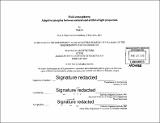Fluid atmospheres : adaptive interplay between natural and artificial light projection
Author(s)
Li, Dan, M. Arch. Massachusetts Institute of Technology
DownloadFull printable version (19.47Mb)
Alternative title
Adaptive interplay between natural and artificial light projection
Other Contributors
Massachusetts Institute of Technology. Department of Architecture.
Advisor
Takehiko Nagakura.
Terms of use
Metadata
Show full item recordAbstract
Imagine. This is the same daily route you travel and the same space you pass through. And it is not. How do we create an adaptive and customized space with no materials at all? Can the generic be customized and specific at the same time? Given extra layers of "light" a compose-able architecture is yet to come. A building is a living, breathing space that is ever moving and rapidly morphing - its animus is time. Take a closer look at the surfaces that enclose our space: there are screens with news, lectures, movie clips; there are windows, shadows and shade created by lights of all different kinds; there are colors and ornamentations that inform us of the history of our architectural lineage. Sunlight naturally creates an evolving atmosphere with the change in time and the seasons; now, with new technologies, we can create even more dynamic atmospheres with light that engage and collaborate with the sun. Light exists in two forms: natural light and artificial light created from technology. Sunlight creates our everyday perception of the physical world, and thus, our ability to understand and live in the space around us. Nevertheless, "digital light" is becoming a larger and larger part of our lives, as we perceive and create information through the medium of a screen. However, "digital light" does not always need to be flat -- through projection mapping, we can create a three-dimensional light that leaves the 2D surface of the screen and is responsive to the environment of the physical world. Using this method, our perception of the physical space will not only change due to the passing of the sun, but also from our own agency in creating altered environments through designed projection systems. This project creates a methodology and a toolkit to design dynamic spaces with natural and projection lighting that allows for customization and alterations of space. Through this system, the static building itself becomes the instrument that is played. This project also demonstrates these tools through investigating projections with light in the atrium of MIT Brain and Cognitive Sciences Complex building.
Description
Thesis: M. Arch., Massachusetts Institute of Technology, Department of Architecture, 2016. Cataloged from PDF version of thesis. Includes bibliographical references (pages 94-95).
Date issued
2016Department
Massachusetts Institute of Technology. Department of ArchitecturePublisher
Massachusetts Institute of Technology
Keywords
Architecture.